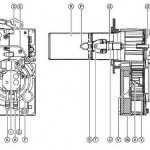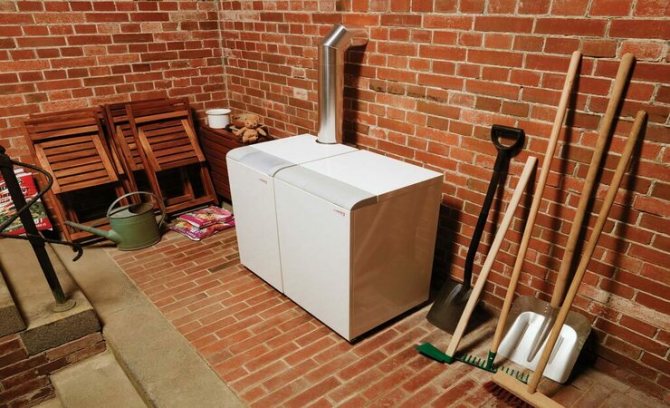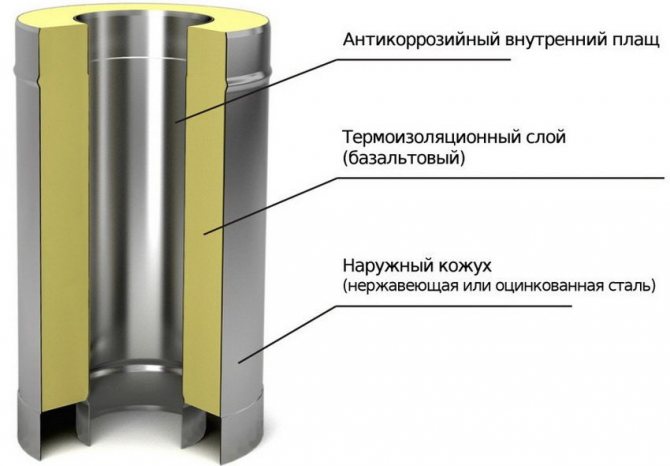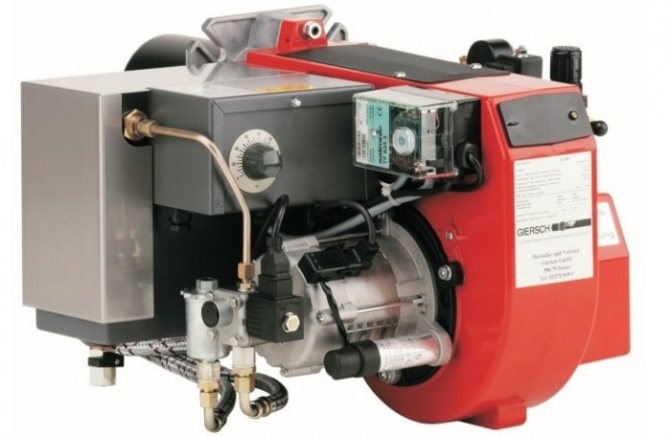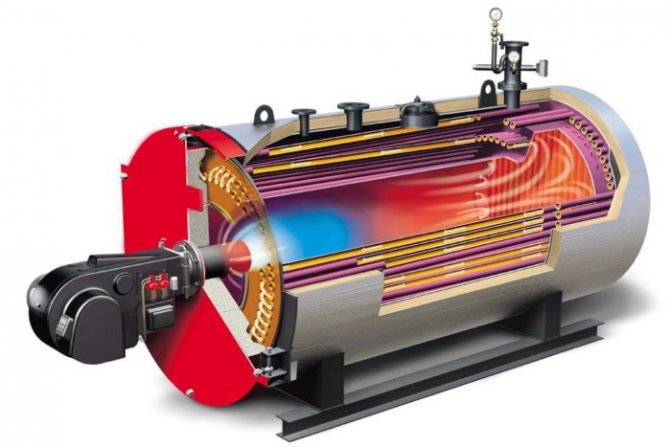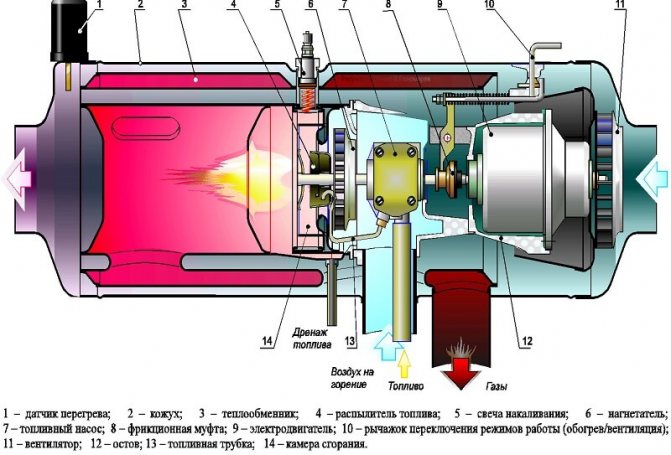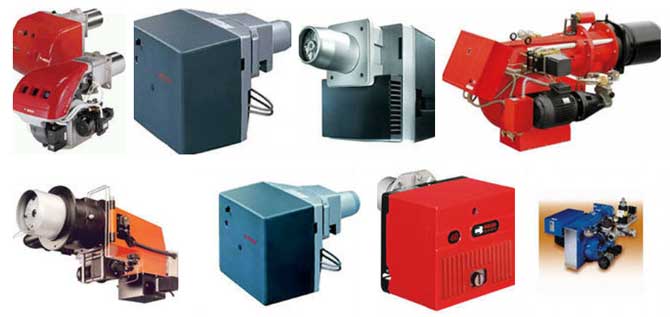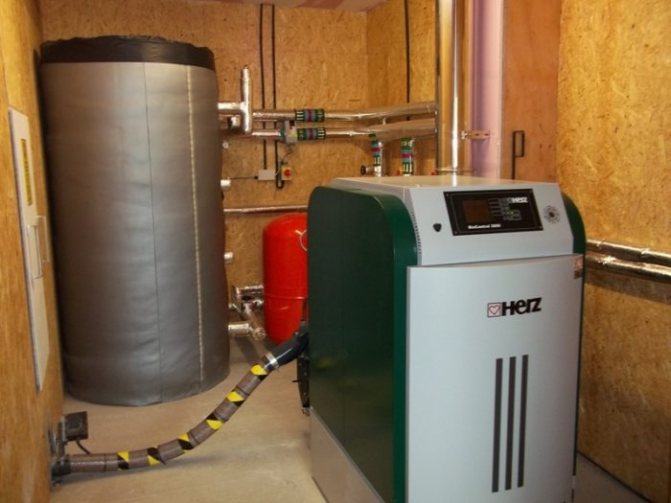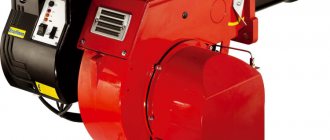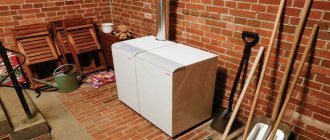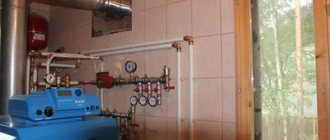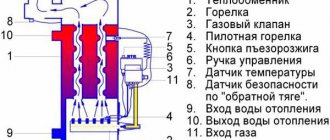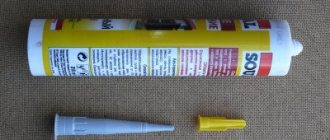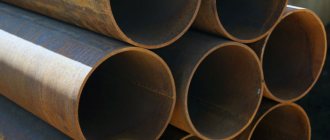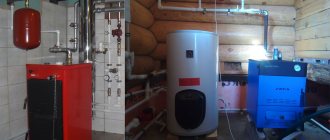Device and principle of operation
As mentioned above, liquid fuel heating boilers are structurally similar to two-pass and three-pass gas boilers. By virtue of their design, the products are manufactured in floor-standing design.
For reference. In boiler systems with a fire-tube heat exchanger, the combustion products can change the direction of movement several times, making several passes through the fire tubes and intensively giving off heat to the water jacket. According to the number of strokes, the heat exchanger is assigned a characteristic - three-way or two-way.
The similarity lies in the design of the heat exchanger made of flame tubes enclosed in a water jacket. In the very center there is a chamber for burning fuel, only for a diesel unit it has a cylindrical shape. This is due to the design features of the burner using liquid fuel. The main elements and details are shown in the figure.
the device of the Viessmann oil-fired boiler
A - external heat-insulating shell; B - heat exchange surfaces of the flame tubes; C - combustion chamber; D - electronic control unit; E - burner device.
In the products of leading foreign manufacturers, the firebox is made of heat-resistant stainless steel, low-cost domestic heat generators can also be made of ordinary thick metal. The material of the heat exchanger is cast iron or steel; basalt fiber or dense polyurethane foam is used for thermal insulation. A burner that runs on liquid fuel and is of particular interest, its design with an explanation of the elements is shown below.
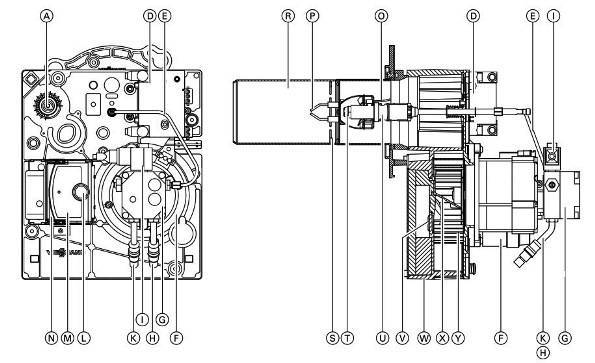
Diesel burner drawing
A - throttle valve for air regulation; D - block of ignition system with flame control sensor; E - fuel line; F - fan motor; G - pump; K, N - supply and return pipelines for fuel; І - electromagnetic valve; L - button for resetting the malfunction signal; M - automatic heating control; N - console; О - ignition cable; Р - electrodes of the ignition system; R - cylindrical working part; S - mixing device; T - nozzle; U - rod with fuel heater; V - air intake device; W - burner body; X - air channel; Y - fan impeller.
The working part is made in the form of a cylinder with many holes, through which the flame passes. When the fuel is burned, the burner flame heats the cylindrical walls of the furnace, as shown in the photo.
Oil burner operation
A special container is intended for the fuel, it can be free-standing or suspended from the wall, a supply line is laid from it to the burner. Some burners have a return fuel line to relieve pressure, then the installation of the boiler and its connection are provided for by two pipes - supply and return, going to the tank with fuel. Ignition is carried out in automatic mode at the command of the control unit.
Top manufacturers
Each boiler manufacturer tries to produce a unit with its own burner. Some people adapt the boiler to other brands of burners.
Most popular LPG burners: Riello diesel burner, Danfoss modulating burner, Lamborghini diesel burners, Simemack 8 diesel burners, Elco diesel burners, Buderus Logatop DE, Weishaupt, Bentone, De Dietrich M Baltur, F.B.R. and Ferroli.
Buderus Logatop DE 1.2H-0050
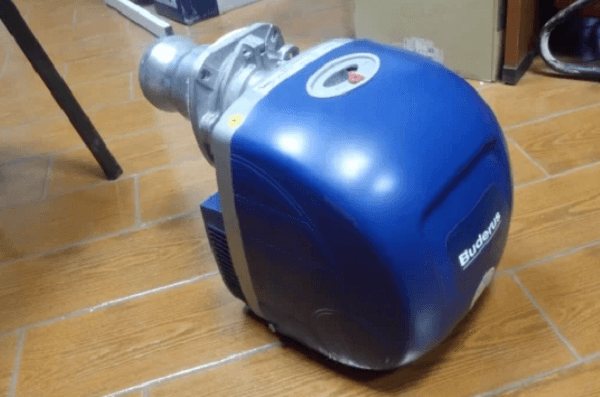

German single-stage burner for diesel fuel with fuel preheating, capable of providing a thermal power of 40 kW at an hourly diesel consumption of 6.4 km / h.
The burner is made in a monoblock design and is 100% ready for operation. The electrical elements are made in the form of plug connections, which ensures a quick start of the boiler into operation.
A hybrid fan is installed in the design. The flame is monitored with an ionisation electrode. These diesel burners for boilers are equipped with an LCD control display, with operation regulation, parameter display and self-diagnosis system. Price: 63 200 rub.
Giersch GU 20 Series
Universal burner of the German brand Giersch for two modes of operation. It can work on various types of waste oils, waste, both from industrial and agricultural production.
When changing types of fuel, re-equipment of the device is not required, this is achieved due to the fact that the diesel is atomized under high pressure.
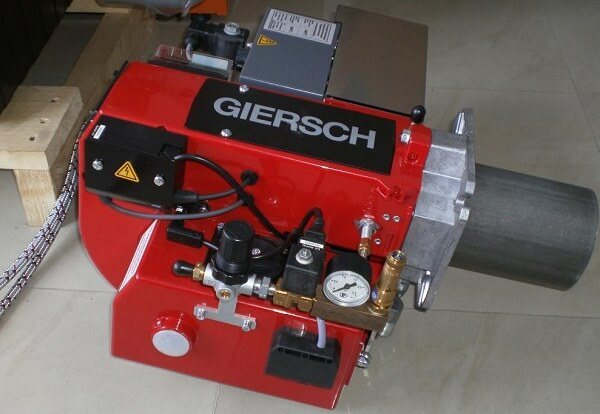

The pump pumps fuel into the burner vessel, in which the liquid level is maintained by a float. A heating element is built into the fuel tank to heat the fuel. The heating mode is from 55 to 140 C, which is capable of heating any fuel, even fuel oil, to a liquid state. The burner is equipped with a compressed air supply. Diesel consumption per hour - 2.7 kg / hour Price: RUB 115,665
Teplamos ECO 150
The Russian burner Teplamos EKO 150 operates on various types of fuel: waste engine oil, furnace oil, diesel fuel, fuel oil and oil waste from agricultural production.
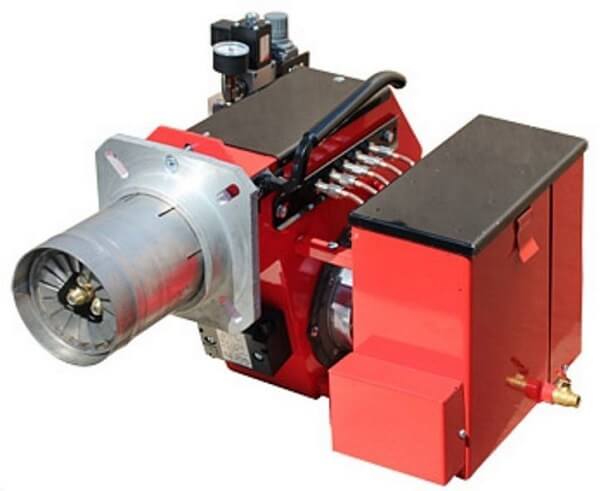

The Teplamos model has the lowest noise parameters. They are standard sized to fit most machines. The device operates on compressed air from an external compressor with a thermal power of 150 kW, with an hourly fuel consumption of 11.0 kg / h. Price: 108 900 rub.
What are long-burning coal-fired boilers for private houses
A long-burning coal boiler is a modern heating device designed to generate heat energy and then heat the coolant by burning certain types of solid fuels, mainly coal and brown coal, anthracite, coal briquettes, etc.
Application and effectiveness
Solid fuel boilers do not need an advance design of a construction project, therefore they are used everywhere - not only for the formation of a new one, but also for the modernization of an existing heating system in a room (for domestic, industrial and commercial purposes).
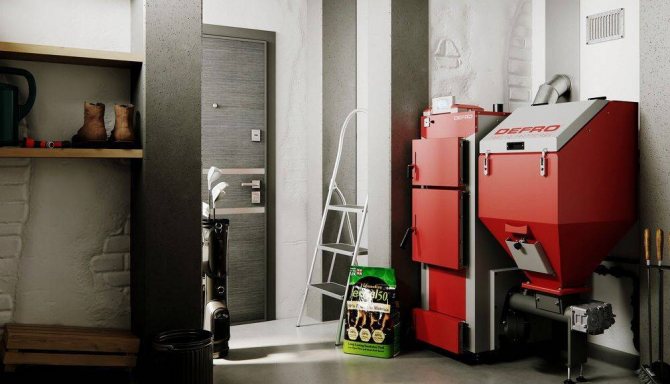

Coal operation does not imply dependence on network communications, therefore such boilers are ideal for private houses located in non-gasified areas. In such conditions, they fully reveal their potential, since, if desired, they can be adapted for the preparation and heating of water.
The efficiency of long-burning coal-fired boilers reaches 80–87% (against the standard 70–75%), but they cannot be called a very cheap heating option.
Comparison of the efficiency of long-burning coal-fired boilers (table):
| Main resource | Calorific value, mJ (kW) / kg (m3) | Fuel price, RUB / t (m3, kW) | Efficiency | The cost of kW of heat, rubles |
| coal | 22,1 (6,2)–27,6 (7,7) | 6000–7000 | 80–87 % | 1,04–1,20 |
| coal anthracite | 28,3 (7,8)–31,1 (8,7) | 8000–8500 | 80–87 % | 1,12–1,28 |
| natural gas | 33,5 (9,3)–36,5(10) | 5400–5700 | 90–95 % | 0,60–0,64 |
| chopped firewood | 11,2 (3,1)–14,3 (4,0) | 1500–1800 | 60–65 % | 0,69–0,80 |
| electricity | 3,6 (1) | 2.5-4.3 (tariff) | 98–99 % | 2,55–4,34 |
As can be seen from the table, gas boilers are the most profitable from a financial point of view. When burned, gas is converted into thermal energy almost completely, so there is no need to “waste” pay for waste, which is inevitably generated when burning any solid fuel.
The cost of firewood is also lower than coal, but in the long term, such heating still loses: since wood has a lower density and mass, with the same volume of the furnace, a full load of firewood (even taking into account the increase in burning time) is enough for 8-48 hours, and coal burns up to 1-7 days.
Device and principle of operation
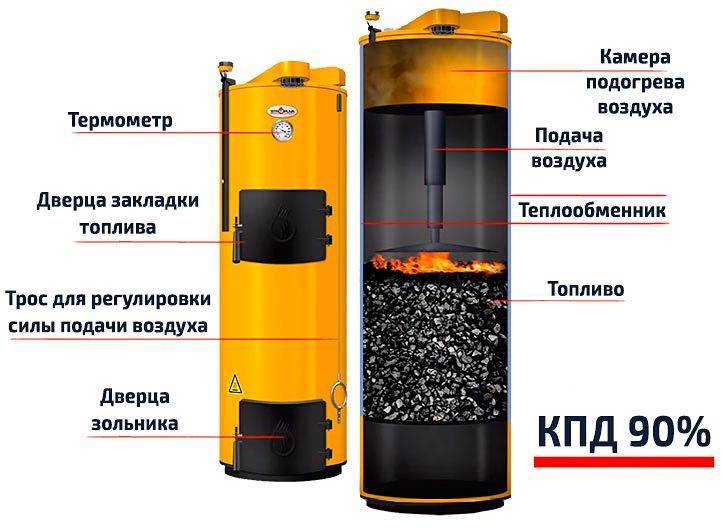

The principle of operation of a long-burning coal-fired boiler on the example of the Stropuva S20 model.
The device of long-burning coal-fired boilers is generally similar to any other solid fuel units, but it has some features:
- loading chamber - occupies almost the entire internal space of the cylindrical body, which explains the increased capacity of the boiler;
- the entrance to the firebox is necessarily located in the upper third of the loading chamber, while the door itself can be located both vertically and horizontally;
- the air chamber is at the same time a recuperator, due to which the air in it heats up and enters the combustion zone already hot;
- movable distributor - is a flat metal "pancake" required for metering air on the fuel combustion surface;
- telescopic duct - looks like a dynamically lengthening tube that connects the air chamber and the distributor;
- ash pan - it is placed as standard in the lower part of the body, but it no longer plays the role of a blower, as in conventional boilers, therefore it must be hermetically closed;
- chimney - has a "broken" (knee) shape, so the smoke, passing through it, better accumulates heat and is discharged into the chimney already cooled;
- heat exchanger - "water jacket" is built into the boiler body; it (unlike a coil) surrounds the combustion chamber and the chimney channel around the entire perimeter.
At first glance, it may seem that a long period of continuous operation is achieved by increasing the loading chamber, but this is not entirely true.
The principle of operation of such boilers is to implement "upper combustion": for this, air is supplied not from below - through the grate, as in conventional boilers (direct combustion), which operate on natural draft, and from above - through an air duct, using forced flow.
In such conditions, the combustion process becomes completely controllable: it is active only in the air supply zone and almost does not affect the bulk of the fuel. In fact, combustion is reduced to layer-by-layer smoldering (without a flame) - from the upper layers to the lower layers, which provides a more uniform heat transfer.
Visual process of long-term burning of coal.
Gas-burners
In Russia, of all types of burners for heating boilers, the gas burner is the most common. They are used for all types of gas boilers, they can be used in boilers operating on natural and liquefied gas. Gas burners are easy to use, they work very quietly and do not smoke. By the method of supplying combustion air, they are divided into atmospheric burners and forced draft burners. Atmospheric gas burners. In atmospheric burners, air enters the combustion zone due to the injection effect. That is, the gas entering the burner tubes "captures" the amount of air necessary for normal combustion. The main advantage of the atmospheric gas burner is the low noise level during its operation. There are no drawbacks as such, but there are a number of factors to which atmospheric burners are especially sensitive. Firstly, the dependence on the gas pressure in the pipeline (it should not be less than a certain value, otherwise burnout of the burner pipes is possible). The protection against this nuisance is the gas pressure control relay, which turns off the burner in case of gas pressure decrease below the permissible limit and turns it on when the pressure is normalized. Secondly, the response to unstable voltage. This factor, by and large, applies to all types of burners and, in general, any modern volatile equipment.With voltage surges, the likelihood of failure of electronic components of automation increases; when the voltage drops to 180 - 160 volts, the gas valves of atmospheric burners may not open. The problem is solved by installing a high-quality stabilizer or, if a power outage occurs periodically, it is possible to install an uninterruptible power supply. Thirdly, construction dust generated in large quantities during construction work is detrimental to the operation of the burner. When it clogs the burner pipes, it becomes difficult for gas to pass into the combustion zone and they burn out. This problem can be solved by minimizing the operation of the boiler during "dusty" work, installing a tightly closing door to the boiler room, and regularly wet cleaning the boiler room. Subject to all the recommendations and regular maintenance, a boiler with an atmospheric gas burner can faithfully serve you for more than a dozen years. Pressurized gas burners - these are gas burners with forced combustion air due to the operation of a blower. The main difference between a forced draft gas burner and an atmospheric one is a wide range of adjustable power, which makes it possible to more accurately adapt the heating system to specific conditions. Most European manufacturers of inflatable gas burners have taken care of their interchangeability, that is, several options for gas burners can be selected for almost any boiler. The disadvantage of a pressurized gas burner is the higher (compared to atmospheric) noise level generated by a running fan. The solution to this problem is to build a stand-alone boiler room or use exhaust gas silencers and sound-absorbing casings. Measures for soundproofing the boiler room are also effective. Nowadays there are fully pre-mixed pressurized burners, the so-called "premix" burners. They use a gas-air Venturi mixing device, which ensures an optimal gas / air ratio over the entire power range. They also abandoned the classic swirlers and nozzles in favor of a special flame tube with a refractory mesh, which is evenly covered with flame during operation. As a result, it was possible to significantly reduce the noise of the gas burner due to the use of a less powerful fan with a variable speed and to expand the applicability of forced draft burners in low-power boilers with compact combustion chambers due to the absence of a classic torch. Low gas pressure and increased dustiness, unstable power supply - all this also affects the quality of the forced draft burner.
Boiler location
The regulatory framework that would regulate the installation of a solid fuel boiler in a private house has not yet been developed. Nevertheless, the basic requirements for the placement of such equipment can be found in the SNiP "Heating and Ventilation" and SNiP 31-02-2001 "Single-family houses" (for the Russian Federation), as well as a number of other individual acts.
It is worth noting that the SNiP "Boiler Installations", often mentioned on the Internet, is not designed for household appliances of low power - its requirements apply to equipment with a capacity of more than 360 kW, and the rules for installing gas equipment are too strict.
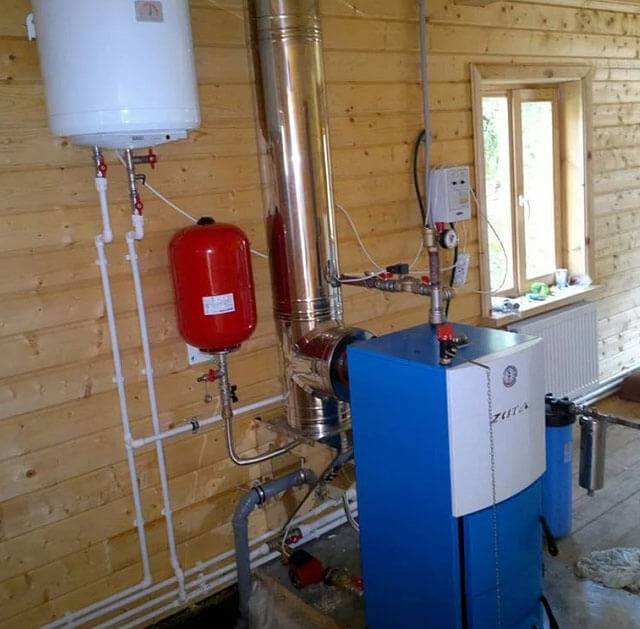

Based on the analysis of the available regulatory framework, which relates to the procedure for placing heating devices on wood, the following tips can be distinguished on how to install a solid fuel boiler in a house:
- Any type of solid fuel, be it wood, coal or pellets, creates a lot of dust. In addition, during the operation of the boiler, different amounts of smoke can enter the room. In this regard, it is not recommended to install a solid fuel boiler inside the living rooms of the house.Although the regulatory framework does not directly prohibit the installation of a solid fuel boiler in the kitchen, corridor or other rooms, with the exception of the bedroom.
- The best option for placing a solid fuel boiler will be an equipped separate boiler room or a boiler room attached to the common house. You can also stop at technical rooms in the house itself, basement, garage or corridor with good ventilation.
- Heating equipment should be located as close to the outer wall as possible in order to facilitate the laying of the chimney, not create too long a horizontal section or not lead the pipe through the ceiling.
- Any solid fuel boiler needs periodic cleaning of the heat exchanger and maintenance. Therefore, it is necessary to provide free access to it. To do this, at least 1 m of space is left in front, and about 60 cm at the back and sides, but at least 25 cm.
- It is forbidden to connect the gas flue of a solid fuel boiler to brick ventilation ducts inside the walls.
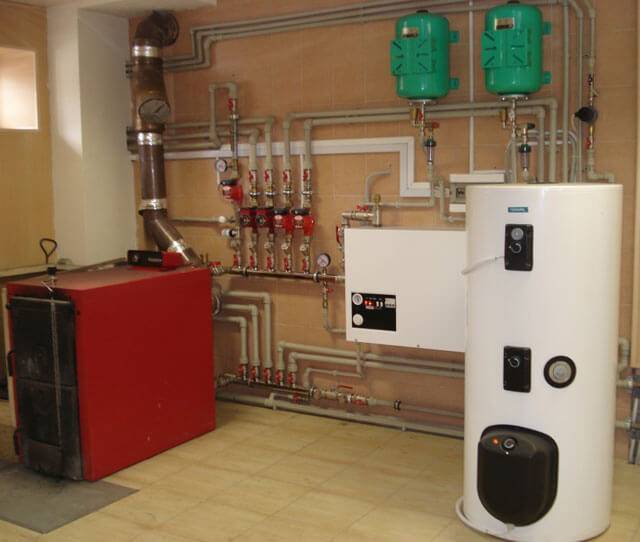

In small-sized boiler rooms, it is possible to place heating equipment close enough to the wall, but only on the unattended side. In this case, the gap can be at least 10 cm, and at least 25 cm must remain behind.
Recommendations for choosing diesel boilers for country houses
- Heat exchanger type - boilers are offered equipped with a cast iron or steel heat exchanger.
- Features of work - boilers on diesel fuel for heating private houses, country cottages, are produced in the classic version, designed for connection to high-temperature heating systems. Leading leaders in the production of boiler equipment, have developed condensing boilers, characterized by high efficiency and economy and working with heating systems , low temperature type.
- Automation and control unit. Diesel boilers operate as fully autonomous and independent heating stations. As an option, a remote control and notification unit is provided. Control over work processes is carried out through any mobile device.
- The number of contours.
- Performance.
- Manufacturer's brand.
- Cost.
Single-circuit or double-circuit diesel boiler
- Single-circuit boilers are large-capacity models designed for connection to the heating system. The possibility of heating hot water is not provided. If later, it is required to connect DHW, an indirect heating boiler is built into the heating system. The advantage of single-circuit models is the ability to heat large houses.
- Double-circuit boilers - the device provides DHW and heating circuits. Depending on the manufacturer, a bithermal or separate heat exchanger is used in the design. Modern models are equipped with a built-in storage tank. The advantage of this design of a diesel boiler on diesel fuel is the instant supply of hot water to the consumer, immediately after opening the water supply tap.
What brand of diesel fuel boiler to choose for home
- The rating of boilers is traditionally headed by the products of German companies. Brands stand out favorably:
- Buderus Logano G125 and G225 series,
- Viessmann Vitorondens,
- Vaillant iroVIT VKO.
- French boilers are in no way inferior in quality: Judging by their popularity with European consumers, De Dietrich managed to create serious competition for boilers made in Germany.
- A domestic buyer prefers cheaper brands made in Italy:
- Fondital Capri series RTF and RTFD,
- Nova Florida series BTF and BTFD, RTF and RTFD.
- Korean:
- Kiturami STSO and Turbo series,
- Olympia OLB.
- There are products that have recently appeared on the heating equipment market, but have already gained popularity:
- DanVex B (Finland),
- EnergyLogic EL (USA).
Device selection criteria
Domestic liquid fuel boilers are manufactured by both European and domestic companies. When choosing, you should pay attention to the main characteristics of the device. You need to consider:
- power;
- price;
- functionality;
- availability of additional functions.
The optimal power of the device must be calculated by a specialist. The functionality of the units is manifested in the fact that single-circuit models are aimed only at heating. Double-circuit can not only heat, but also be connected to hot water supply.
Prices for liquid fuel devices are different. German-made models are the most expensive, most of them belong to the premium class. The middle price category is represented by devices from Korea. They are multi-layered and fully automated. The most accessible are models of domestic production.
An important factor when choosing a heater is the manufacturer's brand itself. The most popular products are from the following manufacturers:
- Gecko;
- 5Energy;
- Viessmann;
- De Dietrich;
- Navien;
- Kiturami.
Read more: korean boiler Kiturami.
The choice of a specific device depends directly on the budget and the wishes of the owner. Domestic models are in no way inferior to European ones. They are not whimsical to raw materials and are equipped with automatic control.
Features of fuel loading and operation
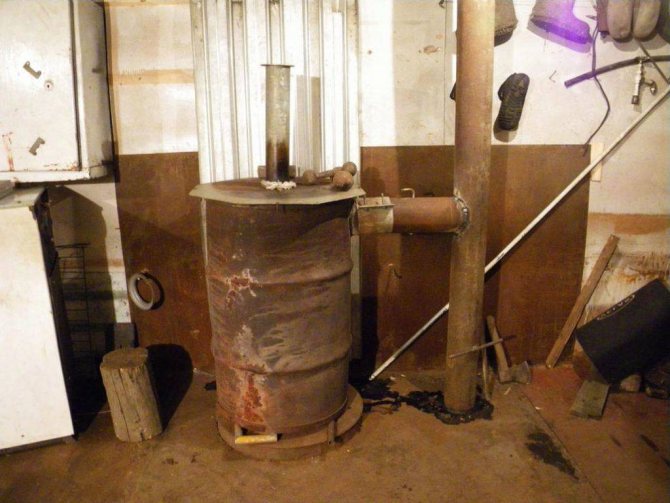

Heating system assembly
From a simple boiler, where a full-fledged air supply is necessary throughout the entire volume of fuel combustion, the design of long-term combustion, as noted earlier, differs in the limited supply of this supply. Moreover, the volume of loading directly affects the combustion time, therefore, in our case, the furnace is loaded extremely tightly so that there are no gaps.
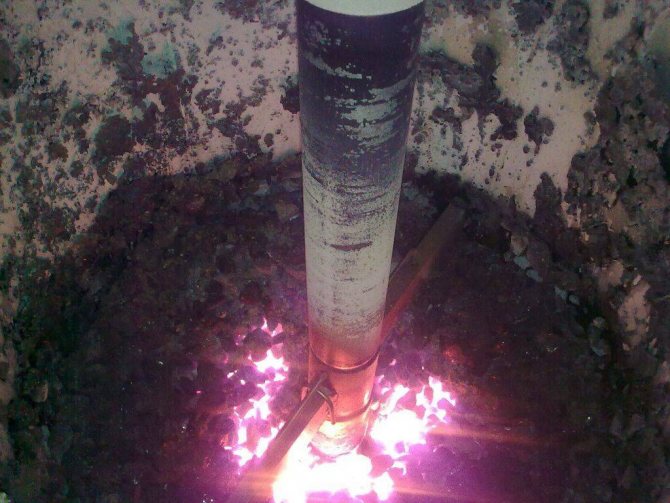

Firebox from the inside
The fuel is loaded in this sequence.
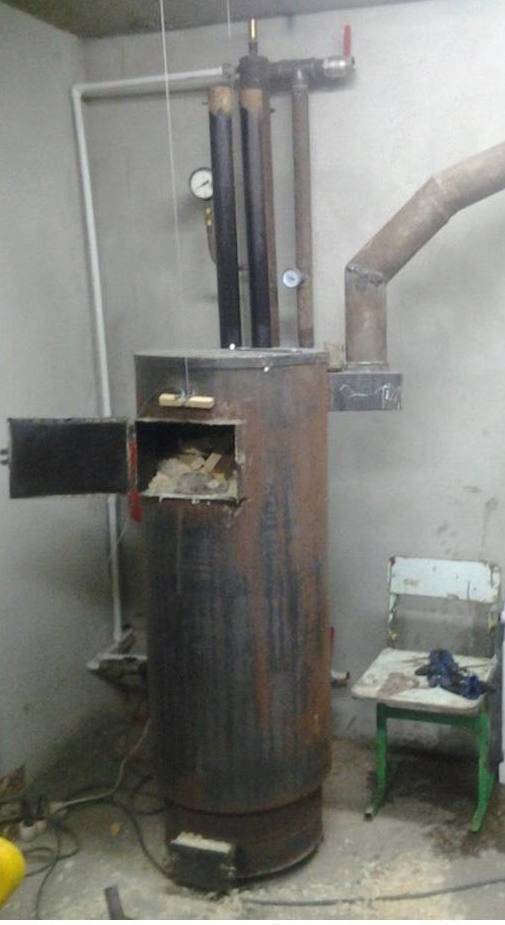

Boiler loading
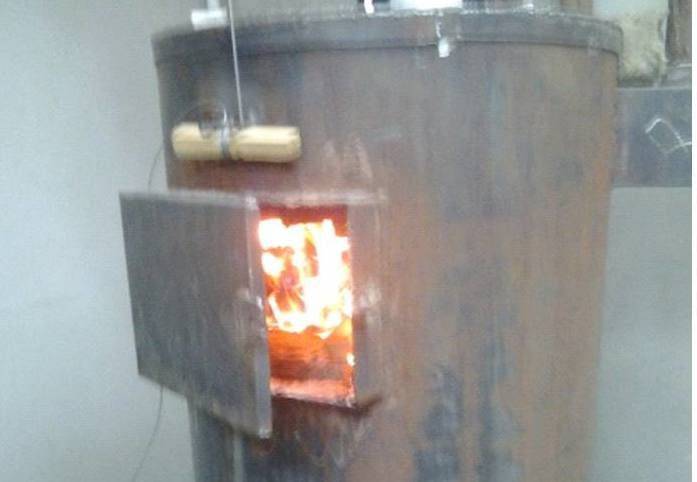

Trial boiler firing
Step 1. The top cover of the structure is removed.
Step 2. Remove the air regulator.
Step 3. The boiler is loaded with fuel up to the level of the chimney.
Step 4. From above, the fuel is poured with a small amount of ignition fluid (diesel fuel, waste oil, etc.).
Step 5. The air regulator is put back and the cover is put on top.
Step 6. The air damper opens to the limit.
Step 7. A piece of paper is set on fire and thrown into the structure. When the fuel starts to smolder, the choke closes.
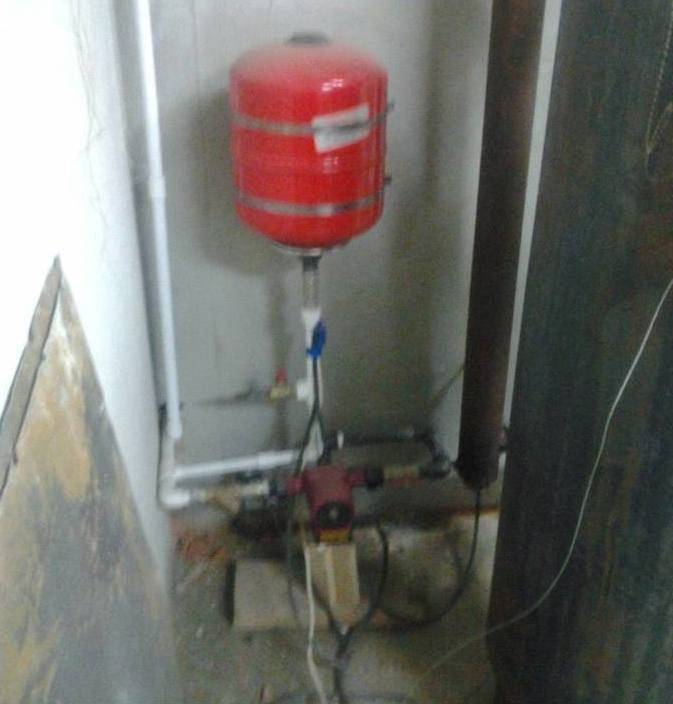

Heating system. Strapping
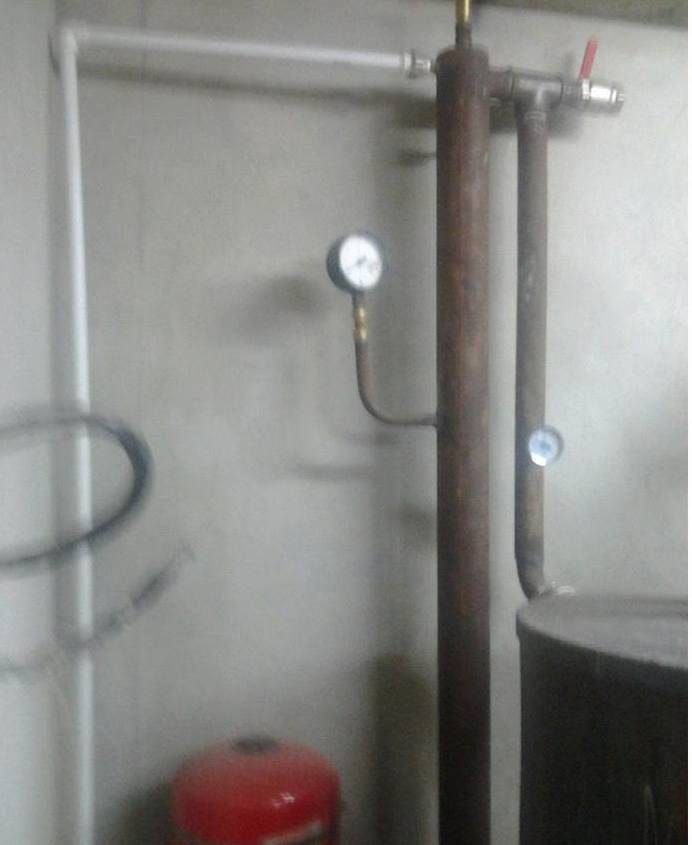

Heating system. Strapping
The fact that permanent combustion has begun can be judged by the smoke emerging from the chimney. As the fuel burns, the pipe of a smaller diameter will go down together with the air regulator - according to this kind of indicator, you can determine the amount of remaining fuel.
Oil fired boiler
In principle, a liquid fuel boiler (or several paired boilers) can be used as a boiler station, but then it is more profitable to heat it with fuel oil, because with the same consumption of fuel oil and gas, the specific heat released from gaseous fuel is much less. There is, however, one sin in such heating devices, which is not that it spoils the overall picture, but makes one think about the fundamental installation. We are now talking about ignition (start of operation), which is the basis for the operation of the boiler and the beginning of the heating season. It is no secret that any hydrocarbon is ultimately a combustible material (some require appropriate processing), but, unlike gasoline, oil and diesel fuel start the combustion process from higher temperatures (this can be seen if you try to light a few drops of gasoline from a match) and fuel oil).
Liquid fuel boiler design
That is, all other things being equal, heavier hydrocarbons have a higher ignition temperature, from which it can be concluded that the design of a liquid fuel boiler should have a pilot igniter and refractory elements of the heat exchanger with a serious combustion duration. Diesel fuel, fuel oil and oil provide stable and long-term combustion provided that fuel is systematically added to the combustion chamber.
The simplest device for a liquid fuel boiler
The easiest option for understanding and describing the properties of such types of boilers is a do-it-yourself stove with a dropper. A standard furnace for stoves has a door for kindling with ordinary wood, and at the top there is a steel drip chamber through which the fuel goes directly into the combustion chamber. To ignite the unit, it is necessary to flood it like an ordinary stove, let it warm up, and then open the dropper to a minimum. Adjusting the dosing of liquid fuel automatically increases or decreases the combustion temperature, and the combustion force (intensity) is controlled by a blower (supply ventilation). The smaller the volume of incoming air, the weaker the combustion, the safer the fuel and the more stable the heating temperature.
Heating on liquid fuel can be organized only with an uninterrupted supply of fuel, therefore it is not recommended to extinguish boilers on liquid fuel for a short time (only for the summer period). The creation of conditions for the correct supply of flammable liquid and the timely replenishment of the stock in the tank creates another nuance - a characteristic smell.
Pros and cons
Among the qualitative and technical indicators, there are no unambiguous minuses or pluses, since some, at first glance, negative features may be for the sake of expanding the list of positive aspects. Everything has already been discussed in the article, but it will not be superfluous to recall and classify all the nuances.
So the pros:
- autonomy (in this case, we should talk about isolation from engineering systems and electricity);
- depending on what fuel can be used: if only one type is a minus, and if the boiler is represented by a combined system, this is a plus;
- stable combustion and maintaining an even temperature (provided that the dosage is the same, maintaining combustion, even with wind or precipitation, is not difficult).
As 100% cons, we note:
- heavy heating of the fuel to reach the ignition temperature;
- no pauses in the heater operation (unjustified fuel consumption);
- regulated minimum temperature in the system (each has its own and depends on the volume of the coolant, the size of the combustion chamber and the density of the hydraulic connection).
Diy waste oil boiler (video)
Principle of operation
The burner is the most important component of any boiler. Models designed to work with liquid fuels have a complex structure. The main element of the burner is the nozzle, which has two channels:
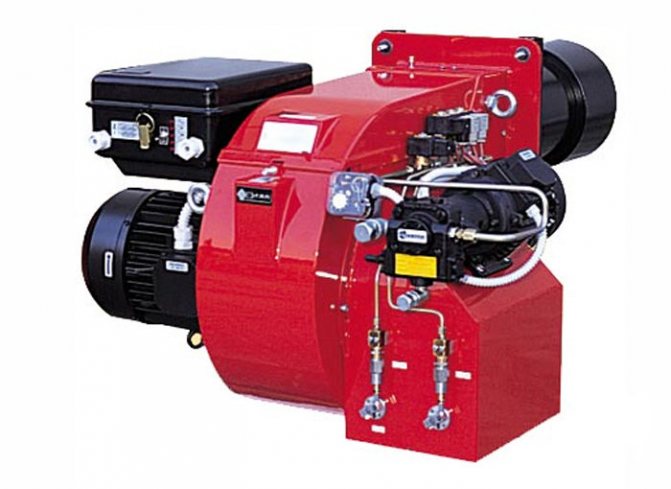

- the first is necessary to supply fuel under pressure;
- the second is for air supply.
Fuel is supplied to the burner by a pump and air is supplied by a fan. In the nozzle, both media are mixed, forming a working mixture that burns in the combustion chamber with the formation of heat.
Advice! The nozzles differ in hole sizes. The larger the hole, the more powerful the burner will be and the more area the boiler can heat.
An automatic control unit connected to a temperature sensor is used to control the operation of the injectors. The unit automatically stops and starts the equipment according to the entered program. For this, a special device is installed in the combustion chamber - auto-ignition.
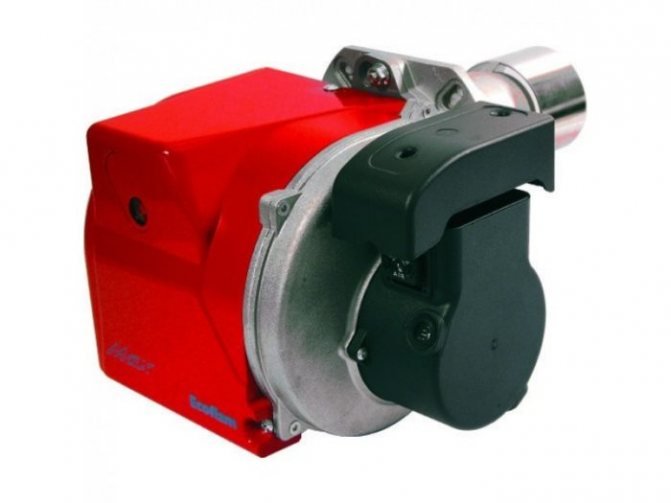

Modern burners are complex devices that are equipped with a special chamber for preheating diesel fuel. The fact is that this type of fuel acquires viscosity at low temperatures, therefore, if it is not provided with preheating, it can clog the nozzle channels.In addition, the unit is equipped with a fuel return line, through which excess fuel flows back into the reservoir.
Scheme of work
Algorithm of operation of heating equipment with a fan burner:
- temperature sensors that constantly monitor the temperature of the coolant, send signals to the control unit;
- the control unit regulates the operation of the equipment according to the settings that the owners set for it;
- when the temperature of the coolant drops to the set temperature, the burner starts up: the pump turns on, which supplies diesel fuel (or another type of liquid fuel) to the nozzle, the fan immediately starts to work, which pumps air into the nozzle channel;
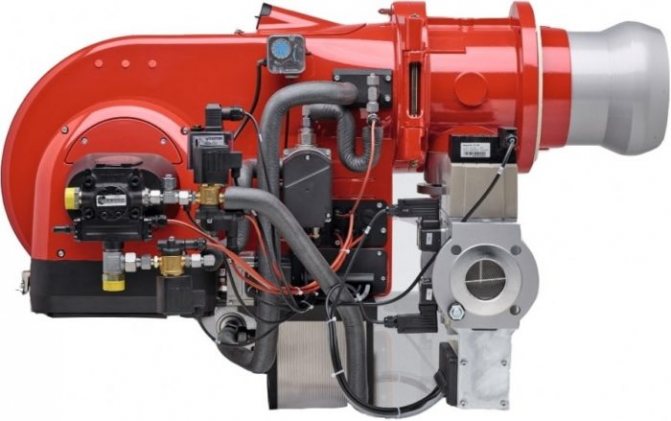

- the working mixture coming from the nozzle is ignited by an electric ignition spark;
- after the temperature warms up, a thermosensor is triggered, which closes the circuit, thereby cutting off the fuel supply.
As can be seen from the above algorithm, modern burners are volatile models, the operation of which is provided by a fan and a pump.
Advice! All volatile boilers are quite sensitive to voltage drops that sometimes occur in the network. To protect your equipment, you need to use a voltage stabilizer.
General information about working boilers
The concept of recycling spent fuel materials has been around since the beginning of the problem of utilizing oily waste. However, in boiler equipment, such an approach has found a full life only recently - since the development of pyrolysis technologies and long-term combustion systems by large manufacturers. These developments are more likely related to the recycling of gas mixtures from solid fuels, but their principles can be transferred to the concept of waste oil boilers. For oil, in this case, a special burner is used, connected to an inversion combustion chamber and a smoke tube.
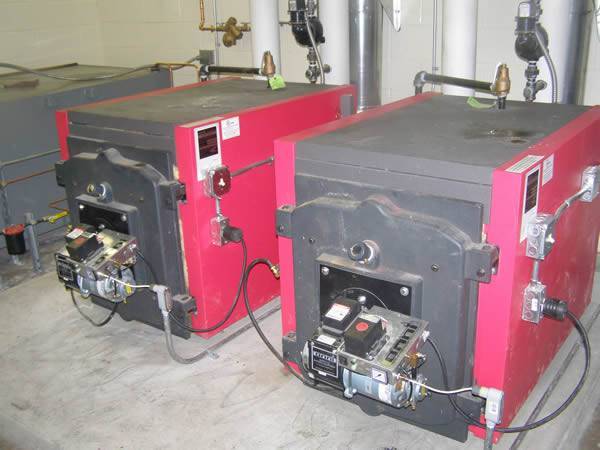

Of course, the main point of difference of this equipment from classical liquid fuel units is the used fuel raw materials. There is still a certain segmentation according to the type of technological development products used, but the future of such models belongs to universalization in terms of fuel supply. One way or another, waste oil boilers for the home mainly work at the expense of kerosene, diesel fuel and other diesel derivatives. Some modifications also support combustion when filled with vegetable oils and special heating oils. In the case of industrial models, we can talk about the use of coarse heterogeneous compositions with impurities.
Diesel fuel oil boiler
A widespread type of liquid fuel units - diesel fuel. They are inexpensive, highly efficient and easy to use. Household heating units using liquid fuel - diesel fuel - do not require special permission to be installed in a local heating network. They can be modified by hand: connected to the gas main.
The diesel heating unit has a design that includes:
- diesel burner;
- fuel filters;
- pump;
- separate control panel for the automated system;
- safety sensors for maintaining stable combustion and the required temperature of the coolant in the system.
- The fuel is mixed with air in an inflatable burner.
- Mixed with air, it passes into the combustion chamber thanks to a powerful fan, where it burns.
- The coolant heats up, like the walls of the chamber in which it is located.
- The gases formed in the process of functioning leave the system of the device through a special chimney provided by the design.
Due to the fact that the boiler on diesel fuel is not much different from the gas one. and it is possible to reconfigure it with your own hands, since the key difference lies in the type of burner.But their modification with their own hands is possible only for diesel fuel boilers with a hinged burner. Such a trick will not work with the built-in one.
Do-it-yourself refurbishment of the furnace with the help of the parts included in the boiler package should only take place according to the proposed drawings and nothing else.
Some manufacturers create 2-in-1 liquid fuel heating boilers that can operate on both diesel and gas. Mostly they are floor-standing. Before purchasing a diesel boiler for the heating system of a private house, it is imperative to calculate the fuel consumption of the device and its heating capacity.
This is easy to do, thanks to the formula: boiler power in kW / 10 = kg of fuel per 1 hour of operation. For a region with average climatic conditions, 3 tons of solarium will be required to supply a building with an area of 300 m 2 with a heat carrier. On average, 0.1 l / hour per 1 kW of device power. Consumption may vary depending on the temperature needs of residents - if someone feels comfortable at a temperature of 22-24 ° C, then for others the optimal temperature will be from 25 ° C. And the higher the temperature, the greater the fuel consumption.
Installation of an oil boiler
To equip a heating system using a liquid fuel boiler, you will need a separate room, like a mini-boiler room. There must certainly be a chimney and an exhaust hood. A prerequisite is the presence of a container in which fuel is stored. It is advisable to install a large tank or barrel so that you do not constantly have to fill it.
A feed pump will be required to transfer fuel from the liquid storage tank to the boiler and piping. If you have experience in such work, all installation activities, from the design of the heat supply system to its launch, can be performed independently. But nevertheless, experts recommend entrusting the installation of heating equipment to professionals who, taking into account all the nuances, provide services competently and in the shortest possible time. An autonomous heat supply system requires the most serious approach to its creation.
Varieties of diesel boilers
So, due to the inability to use other common energy sources, you decided to arrange heating on liquid fuel in your home. It's time to choose a heating boiler, and then you need to figure out what types of these products exist and choose the most suitable option. Manufacturers offer heating boilers for liquid fuel of the following types:
- diesel boilers;
- universal units, they provide for the possibility of switching from diesel to natural gas;
- condensing boilers for diesel fuel;
- installations that burn all types of waste oils.
If in the foreseeable future no change in the situation with energy resources is foreseen, then your option is to heat a private house with a heating boiler of the first type, burning only diesel fuel.
For reference. Most of these installations can operate on liquid biological fuel, which is obtained from industrial crops (biodiesel). This option can be very useful if such an energy carrier is available to you.
Some homeowners looking for a boiler for heating believe that in a diesel boiler they will be able to burn and work off their car. This is the wrong approach, and for the following reasons:
- Not every burner operates on contaminated oils.
- The calorific value of liquid fuels is much higher than that of waste oils. Accordingly, the areas of the heat exchange surfaces are calculated for liquid fuel; during the combustion of the development, the efficiency will be much lower.
- The combustion workout emits significantly more soot, which settles in the entire smoke path. This can be a big problem in the maintenance and cleaning of fire tubes.
By their design, liquid fuel boilers are very similar to heat generators operating on natural gas.Accordingly, many manufacturers offer universal hot water installations with alternating use of liquid and gaseous fuels. The transition from one type of fuel to another is carried out by replacing the burner device. True, a universal boiler that runs on liquid fuel and main gas will cost you a little more.
If the area of the heated room or building is less than 200 m2, and in the near future you expect to be connected to the gas pipeline, then you should not rush to purchase a universal heater.
The fact is that the cost of a boiler block and two burners may turn out to be higher than two separate full-fledged units. Therefore, at first, you can put the boiler on diesel fuel, and after connecting to the mains, buy and install a gas heat generator. You can find out more information by watching the video:
Domestic condensing boilers for diesel fuel are the most economical and efficient representatives of this family of heat sources. Manufacturers declare the efficiency of their condensing units at 97%, which is the highest among all other heaters. As usual, their cost is quite high and not every owner can afford to include such a high-tech product in the heating system.
It is very good if you have access to such a secondary resource as used car oil in sufficient quantities. Then especially for this purpose there is a waste oil boiler, the product is manufactured and offered on the market by many manufacturers. Also, similar boilers for heating are well mastered by various craftsmen who make homemade heaters.
Equipment advantages and disadvantages
Heating boilers for liquid fuel make the house completely autonomous in terms of heating and hot water supply. They have their pros and cons to be aware of. The main benefits include the following:
- ease of installation;
- ease of operation and maintenance;
- automatic fuel supply;
- no need to obtain a special permit for installation;
- high power and efficiency;
- the ability to use for heating both residential and industrial premises;
- boilers are fully automated.
In this video, we will consider boilers for liquid fuel:
If necessary, the type of fuel can be changed by replacing the nozzle. The devices are characterized by a high level of efficiency. The main disadvantages are as follows:
- noise during operation;
- the need to create a separate room for the boiler and fuel storage;
- availability of uninterrupted power supply;
- the need to install a chimney.
More details: do-it-yourself chimney.
The cost of liquid fuel is quite high. Despite all the shortcomings, such boilers are in demand.

